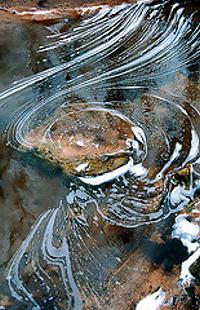
© Bernie KasperFoam on a stream in southeast Indiana.
INDIANAPOLIS - Six of every 100 streams in Indiana contain mercury at levels greater than the state water quality standard protecting human health, according to research released today by the U.S. Geological Survey. With new mapping techniques, the scientists identified an area in southeastern Indiana with some of the highest levels of mercury deposition in the United States.
Mercury concentrations in 73 percent of the samples exceeded the more restrictive state water quality standard protecting wildlife.
More than 80 percent of the water samples had detectable methylmercury, the most toxic form of mercury that accumulates in fish, birds, and mammals at the top of food chains.
In a separate report looking at mercury in rain and snow, USGS scientists found that mercury concentrations in more than 40 percent of the samples exceeded the Indiana water quality standard for human health and nearly all concentrations exceeded the standard protecting wildlife.
"Our studies are showing that mercury can be found in the water everywhere we've looked in Indiana, but the mercury varies from place to place and changes both seasonally and year to year," said USGS scientist Martin Risch, an author on both papers.
Mercury in the atmosphere comes from human activities that include coal-fueled power generation, metals industries, and cement manufacturing. Mercury in streams comes from atmospheric deposition and discharges of municipal and industrial wastewater.
Mercury poses a health risk to humans and wildlife, especially the young. Nervous system and mental development can be diminished by mercury exposure. Mercury levels build up in food chains so that wildlife can be exposed to concentrations that impair their reproduction and survival.
Mercury concentrations in sport fish in Indiana have caused health officials to recommend restrictions or bans on consumption of some fish. These restrictions have a widespread effect because one out of every six Indiana residents participates in recreational fishing.
For the studies published today, scientists from the USGS Indiana Water Science Center in Indianapolis operated five monitoring stations across the state that collected rain and snow samples and measured precipitation every week. The water samples reported in the studies were collected from 2001 to 2006.
The scientists also collected water samples each season from 25 stream sites in the major watersheds draining most of Indiana.
They analyzed the samples for mercury with methods that could detect concentrations less than a part per trillion, using special techniques and equipment to assure the mercury concentrations measured were representative.
Not all of the streams have rising mercury levels. At the five Indiana monitoring stations from 2001 to 2005, the scientists observed a three percent decrease in mercury concentrations and an eight percent decrease in the mass of mercury deposited by rain and snow.
These decreases may be related to a 28 percent decrease from 2002 to 2005 in mercury emissions in Indiana, they said.
"The decrease in mercury deposited by precipitation from 2001 to 2005 is explained by the decrease in the mercury concentration, not by an accompanying decrease in precipitation during that time," said Risch.
But mercury in precipitation is not decreasing everywhere in Indiana.
With a new mapping technique, the scientists pinpointed an area in southeastern Indiana where high mercury concentrations in the rain contributed to some of the highest mercury deposition in the United States.
"The highest mercury concentrations we measured were downstream of urban and industrial discharges or, in one case, downstream from active and abandoned minelands," said USGS scientist Amanda Ulberg, who led the study of stream samples.
The highest unfiltered total mercury concentrations were at six monitoring stations - five that are downstream from urban and industrial wastewater discharges and that have upstream drainage areas more than 1,960 square miles, and one that is downstream from active and abandoned mine lands and that has an upstream drainage area of 602 square miles.
"High total mercury concentrations were associated with increased streamflow in winter and spring when large amounts of fine particulates were suspended in the water," Ulberg explained.
By contrast, most of the methylmercury was detected when water temperatures were warm and streamflow was low.
The USGS, in partnership with the Indiana Department of Environmental Management, continues to monitor mercury in precipitation every week at the five stations in Indiana. These stations are part of a network of more than 110 stations in North America, coordinated through the National Atmospheric Deposition Program.
Reader Comments
to our Newsletter